- Izu Peninsula top
- General
- Earthquake and volcano
- Too many deer in Izu
- East
- Ito - its old buildings
- Anjin = Wlliam Adams and Ito
- Religious Charisma Nichiren
- Washtub race
- Yokikan - Spa ryokan
- Minami-Kaikisen: Auberge
- Ike and its paddy fields
- Summer has come!!!
- Inatori - fish, spa and more
- Central
- Banjo Waterfall
- Mount Amagi
- Shuzenji - old spa town
- Arabashiri - Bandai-Jozo
- Oomi Land - heart of Izu
- West and south
- Heda on the west coast
- Toi - Gold mine
- Matsuzaki - namako wall
- Izu-no-Chohachi - Plasterer
- Kumomi on the west coast
- Shimoda - Tojin-Okichi
- Cottage life
- Fishing in Usami
- Start of my fishing life
- Training camp in Amagi
- Cottage life / music&drinks
- Party in Izu - part 2
- Party in Izu - part 1
- Sunday morning concert
- Ice and snow in Amagi
- My summer house
- Restaurant and eatery
- Let’s eat Izu-Deer!
- Isui-an - exquisite soba
- Sugizen - big prawn fry
- Sayang - Bali restaurant
- Restaurant Tanaka

Distant view of Bandai-Jozo. The Japanese style house on the right is Kaku-sei-kan. A Chimny with the brewery name stands in the center.
Arabashiri - Specialty sake of Izu brewed by Bandai-Jozo

Arabashiri 1.8l
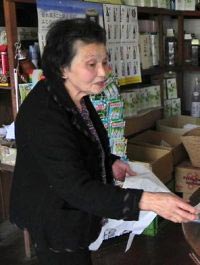
The vivacious mistress eloquently answered any question we posed to her.
On the outskirts of a famous spa resort town Shuzenji, an impressive stone wall rises from paddy fields as if it were once a fortress of a local clan. There are four Chinese characters on the thick chimney: Ban-Dai-Jo-Zo. Bandai-Jozo is the sole sake brewer in Izu and its history can refer back to the end of the 15th century.
According to a legend of Bandai-Jozo, when Hojo Soun (1456-1519) defeated Ito Clan and expanded his rule to Izu Peninsula, he toasted his victory with local sake. Soun was pleased by the taste of sake and gave it the name "Banyou". Banyou means "shines for tens of thousands of generations in tens of thousands of countries".
"Banyou" is the representative sake brewed by Bandai-Jozo in traditional style. In another word Banyou is sweet and does not fully fit the taste of sake connoisseurs in these days. Therefore, Bandai-Jozo introduced a dry type sake "Arabashiri" and Arabashiri is now the best seller of Bandai-Jozo. Arabashiri tastes reasonably dry and refreshing and its 1.8l bottle is priced at mere 1,600 yen.
Unfortunately old documents were burnt out in a fire and there is now no written document which can endorse the origin of Bandai-Jozo. However, the massive stone wall and many findings from the ground make the oral tradition plausible. Some years ago a 300 years old building was brought from a nearby temple and reconstructed in the ground of Bandai-Jozo as Kaku-sei-kan and visitors could enjoy sake tasting there. However, as the vivacious mistress explained me, the brewery had to stop sake tasting in spring last year, because a drunken guest caused an automobile accident and it decided to refrain from offering sake to visitors in the tasteful building.
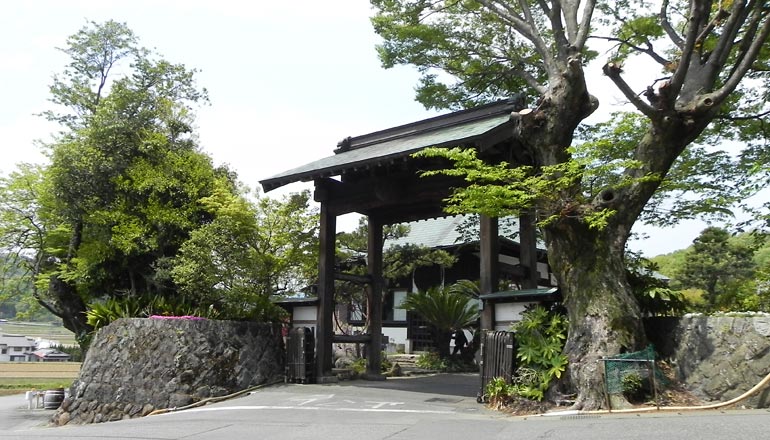
Gate of Bandai-Jozo. The wooden house behind the gate is Kaku-sei-kan.
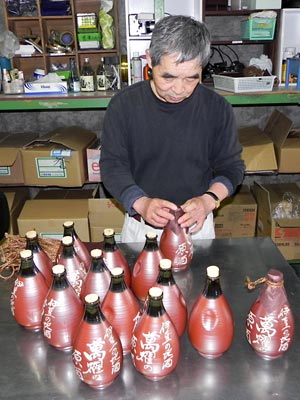
Wrapping gift bottles of Banyou unprocessed.
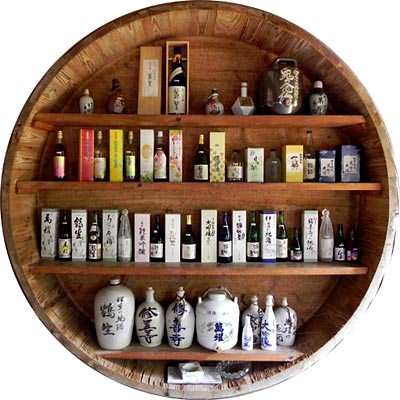
The lineup of Bandai-jozo, displayed in a big sake barrel.
Nevertheless, she kindly treated us in her office/shop and thanks to a friend who drove car in place of me I could check various kinds of alcohol. The large number of products of Bandai-Jozo was indeed a surprise for me, because I had believed that it produces Arabashiri, Banyou and a few other kinds of sake. However, Bandai-Jozo merged a nearby brewery and continues to produce the sake lineup of the merged brewery. In addition, as a sole brewery of the region, Bandai-Jozo is requested to make private brand sake for example for guest houses or municipalities. Thus the number of products has expanded.
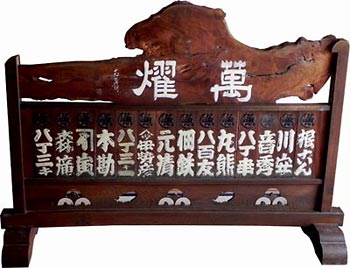
An old wooden screen with the inscription "Banyou" and name plates of sake traders is placed in Kaku-sei-kan.
There are three categories of products: sake, shochu and liqueur. Among its liqueur lineups I tried wasabi (horse radish), shiro-biwa (white loquat) and yama-momo (bayberry). Wasabi, shiro-biwa and yama-momo are all specialties of Izu. While shiro-biwa and yama-momo are fruits and their sweet liqueurs are suitable for making cocktail, wasabi liqueur is distinct with its irritant odor.
Though we were only visitors intending to buy some bottles of sake and other alcohol, the mistress allowed us to visit Kakuseikan and the factory and we followed this kind offer. A large wooden gate welcomes visitors in front of the factory ground. Entering the gate, a somewhat aged factory was seen on the right. In the factory the owner of the company himself was wrapping special Banyou bottles and kindly answered my silly questions. In front of the factory, two large sake barrels are placed and jointly used as tea house. A god of sake is enshrined in the neighboring small shrine. Thereafter we relaxed us in Kaku-sei-kan.
There are a good number of tourist attractions in Bandai-Jozo. However, like sake tasting, they stopped factory visiting some time ago due to an unforeseen accident. It is regrettable. If Bandai-Jozo is open for public again, it canl be another popular tourist destination in Izu.
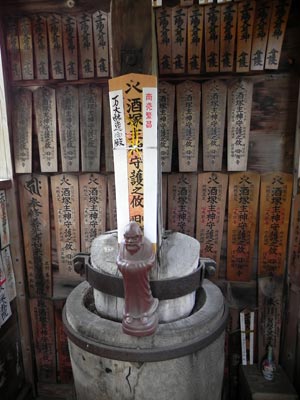
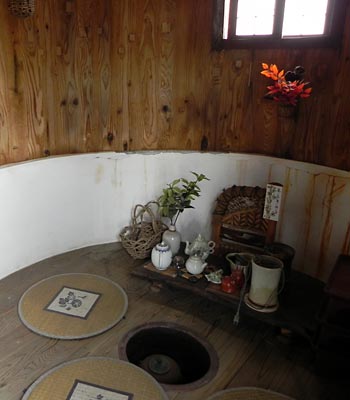
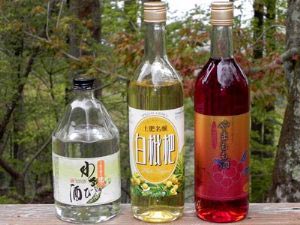
(From left to right)Wasabi, Shiro-biwa and Yama-momo liquere
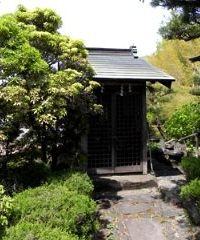
The exterior of sake shrine
I know that there are people who suspect the quality of sake produced by "tourist breweries" such as Bandai-Jozo. They mean that sake breweries in tourism regions tend to make cheap sake for short stay visitors. However, I believe that Bandai-Jozo makes sincere efforts to make good quality products using local ingredients such as rice and water and tries to sell its products at reasonable price so that Izu brand becomes popular.
Arabashiri is a "hon-jozo" type sake. This means that rice is polished to the extent that less than 70% of the original weight is used for making sake. In order to increase freshness distilled alcohol is added. Nowadays "ginjo" type sake becomes more and more popular in Japan and rice is polished till 60% and in case of "dai-ginjo" till 50%. Through this process, fragrance of sake is enhanced. However, ginjo and dai-ginjo uses only a small part of rice and I cannot but think that this is a waste of precious resources. I do like more traditional, less extravagant sake such as Arabashiri.
Not only taste but also price is very attractive! A few days after my visit to Bandai-Jozo, I was in a Japanese restaurant and surprised to see the price list: all sake were priced more than 1,600yen, and not for 1.8 l, but only for 0.18 l.